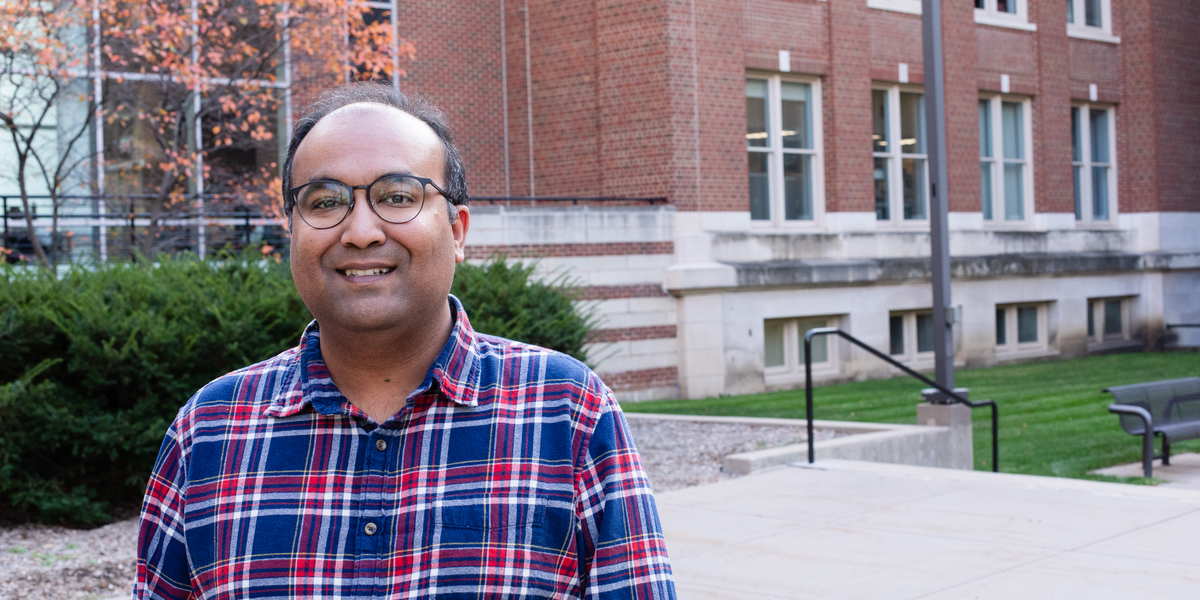
Kanishk Jain never does anything half-heartedly. Scientist by day, clarinet and tenor sax jazz performer by night – both could be their own careers, but somehow he still has time to care for his 200 species of house plants and hand-write letters with one of his 40 speciality fountain pens. One might say Jain is the ultimate embodiment of the “work hard, play hard” mentality.
“How many plates can I spin at the same time without them falling?” he asks, still unsure how he will move his houseplants to Minnesota this January to start his new faculty position in the Department of Biochemistry, Molecular Biology, and Biophysics (BMBB). Jain’s interests outside of research help keep him balanced. “So much of research involves failing and trying again. When you’re really in the weeds with science, you need something to pick you back up.”
Jain’s curiosity and drive are hallmarks of a good researcher. But it took him a long time to decide on his current field. As a senior in high school, he applied to several music schools, then decided to take the science track and start his undergraduate degree as a pre-med student. “Music helps me stay sane, but the curious, analytical part of me won out in terms of career,” says Jain, who was part of Science Olympiad in high school and other extracurriculars that spurred his interest in science. But it was his undergraduate biochemistry experience that really piqued his interest in academic research.
“The principal investigator of the lab I was in showed me these really old electron micrographs that he’d taken in grad school,” says Jain, who says his PI pointed out a specific kind of protein structure on the screen. “I thought, okay, somebody made a model of that, and he said, ‘No, that's the actual protein. That’s the physical molecule – we can actually see it.’” Being able to see science up close awed Jain.
For a long time Jain’s undergraduate research experience inspired him to become a structural biologist. “But, you know, things change. I ended up becoming more interested in enzymology, and then the enzymes I worked on in grad school happened to be involved with histones and chromatin,” he says. Chromatin is the structural protein containing our DNA, and histones control how loose or snug the chromatin is. Jain continued his work with histones and chromatin at the University of North Carolina (UNC) School of Medicine as a postdoctoral researcher. “Histone modifications determine what genes can be accessed by various proteins and enzymes to do a number of biological things in the cell.”
Jain’s will continue to investigate the mechanisms histones rely on to modify our genetic makeup at the University of Minnesota. These modifications can make a huge difference when it comes to gene expression and gene regulation, often studied in a field of science known as “epigenetics.” The best way to understand epigenetics, says Jain, is by thinking of a calico cat. Each color in the cat is controlled by the same genes. So why are some spots on the cat black and some spots orange? The color was determined by the gene expression, which can be modified by gene regulators like histone modifications.
In worst-case scenarios, “broken” gene expression and dysregulation can lead to cancerous cells. “What I research is understanding the machinery that keeps all those things in check, and what happens when those things aren't in check,” says Jain.
Transitioning from a postdoctoral researcher at UNC to an assistant professor in BMBB will give Jain more freedom to pursue his own research interests. He’s excited to make use of the University’s many wonderful facilities to approach his research from a biochemical and structural biological perspective.
He’ll certainly be looking for a new jazz performance club to join as he builds up his lab. “I’m a pretty gregarious person. I like to be fun, but also down to business,” says Jain, who says he’s aware academia can feel like a high-pressure environment and wants his mentees to feel like they have someone who’s in their corner – in a serious, but not-too-regimented kind of way. “I want people to feel like what you get in my lab is support.” – Adara Taylor